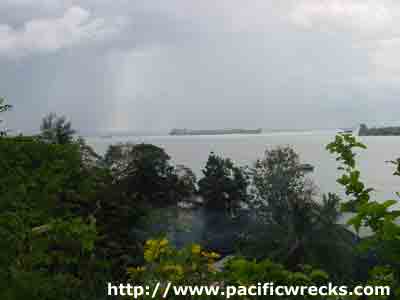|
|
|
|
| Missing In Action (MIA) | Prisoners Of War (POW) | Unexploded Ordnance (UXO) |
| Chronology | Locations | Aircraft | Ships | Submit Info | How You Can Help | Donate |
|
 AWM 1914  David Paulley 1982  Claude Gibson 2001 |
Location Lat 2° 34' 0S Long 150° 48' 0E Kavieng Harbor borders Kavieng on the western tip of New Ireland. Also known as "Kawieng Harbor". Borders Kavieng (Town) to the east with Nusa Harbor, Nusa Island and Nusalik Island to the west, Nago Island and Nausen Island to the southwest and Cape Nuan to the north. Prewar and during the Pacific War located in the Territory of New Guinea. Today located in Kavieng Urban LLG of Kavieng District in New Ireland Province in Papua New Guinea (PNG). Prewar Kavieng was settled by the Germans who built a government station, developed Kavieng Harbor and constructed a network of roads and copra plantations on New Ireland. During World War I, occupied by Australian forces and afterwards administered by Australia. By 1941, the Kavieng Harbor waterfront included Main Wharf (Kavieng Wharf), Chinese Boat slip, Saunders Jetty, Burns Philp Store (B. P. Store). Wartime History During July 1941, a small Australian Imperial Force from No. 3 Section and a force of 250 commandos of the 1st Independent Company arrived at Kavieng and began construction of Kavieng Airfield. On December 25, 1941, as the threat of the Pacific War became imminent, white women and children were evacuated by the administration. On January 21, 1942 over sixty Japanese carrier aircraft attacked Kavieng without opposition. During the night of January 21-22 most Australians were evacuated from Kavieng by 10:30pm. A few opted to stay behind to destroy installations then planned to escape aboard two small ships Navanor and Shamrock. During the night of January 23-24, 1942, a Japanese force from Truk lands at Kavieng and found virtually no opposition. Afterwards, the No. 2 Maizuru Special Naval Landing Force (2nd Maizuru SNLF) was transported to New Hanover, Mussau and Emirau looking for Allied soldiers but found no opposition then returned to Rabaul during late January 1942. Japanese missions against Kavieng January 21, 1942–April 8, 1944 During late January 1942 Kavieng was developed by the Imperial Japanese Navy (IJN) into a base area, anchorage in Kavieng Harbor and shore facilities for Kavieng Seaplane Base was used by seaplanes. Many Japanese veterans recalled the area as "that it is a beautiful place as the heaven". The kanji for Kavieng "Ka-bi-en" translates to "excellent-beautiful-garden". By August 1942, Allied aircraft began bombing Kavieng, culminating in heavy aerial attacks in early 1944 that neutralized the area with bombing and low level strafing and left the area cut off from resupply by ships or aircraft. Due to the heavy attacks in early 1944, the Japanese believed the Allies might conduct an amphibious landing at Kavieng. In response, Japanese Navy Rear Admiral Ryukichi Tamura the commander at Kavieng ordered all Allied prisoners killed due to the expected invasion. At least 25 Australian civilians were executed at Kavieng Wharf (Main Wharf). Japanese and American missions against Kavieng August 17, 1942–April 8, 1944 Allied plans originally called for the invasion of Kavieng. On March 12, 1944 the Joint Chiefs canceled the invasion, in favor of landings at Hollandia and Emirau. Although bypassed, Japanese forces occupied Kavieng until the official surrender of Japan in early September 1945. Today Kavieng Harbor remains in use as an anchorage for Kavieng. Kavieng Wharf (Main Wharf) Built prewar, the Kavieng Wharf extends from Kavieng into Kavieng Harbor. Also known as "Main Wharf". During early 1944, (possibly late February or the middle of March 1944) at least 25 Australian civilians were murdered on Kavieng wharf. At dusk they were led, blindfold, one at a time, from the road to the edge of the wharf and garroted with wire. The bodies were put in two small barges, with concrete blocks tied to their feet, and thrown overboard between Nago Island and Edmago Island. The exact number of civilians killed or all their names is unknown. Among those executed was David Topal who was age 14. Postwar in 1947, Admiral Tamura went on trial with five of subordinates in Hong Kong. At the time the law for war crimes permitted only British deaths to be prosecuted and German priests and other non-British civilians were not mentioned in the prosecution. Kavieng Seaplane Base B-25D "Gremlins
Holiday" 41-30041 B-25C "Pissonit" 41-30370 B-25D Mitchell 41-30531 Contribute
Information Last Updated
|
Map 1944 Map Fallingrain Photo Archive |
| Discussion Forum | Daily Updates | Reviews | Museums | Interviews & Oral Histories |
|